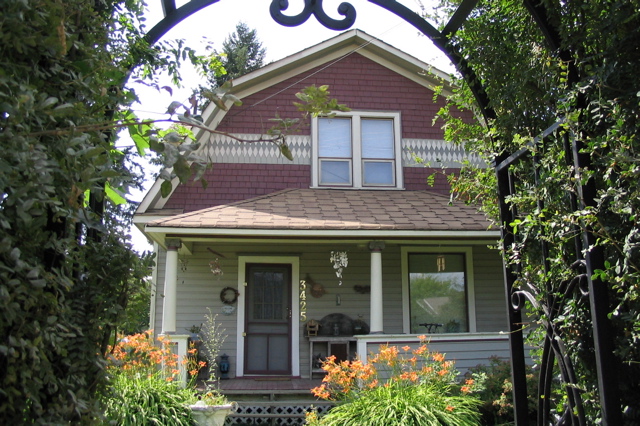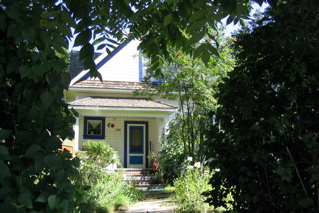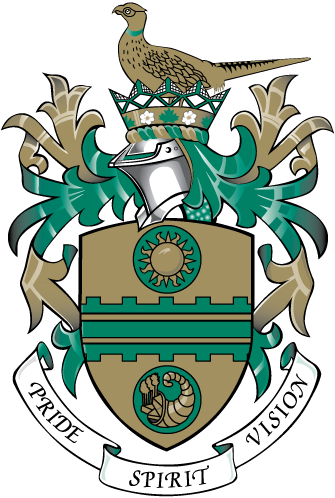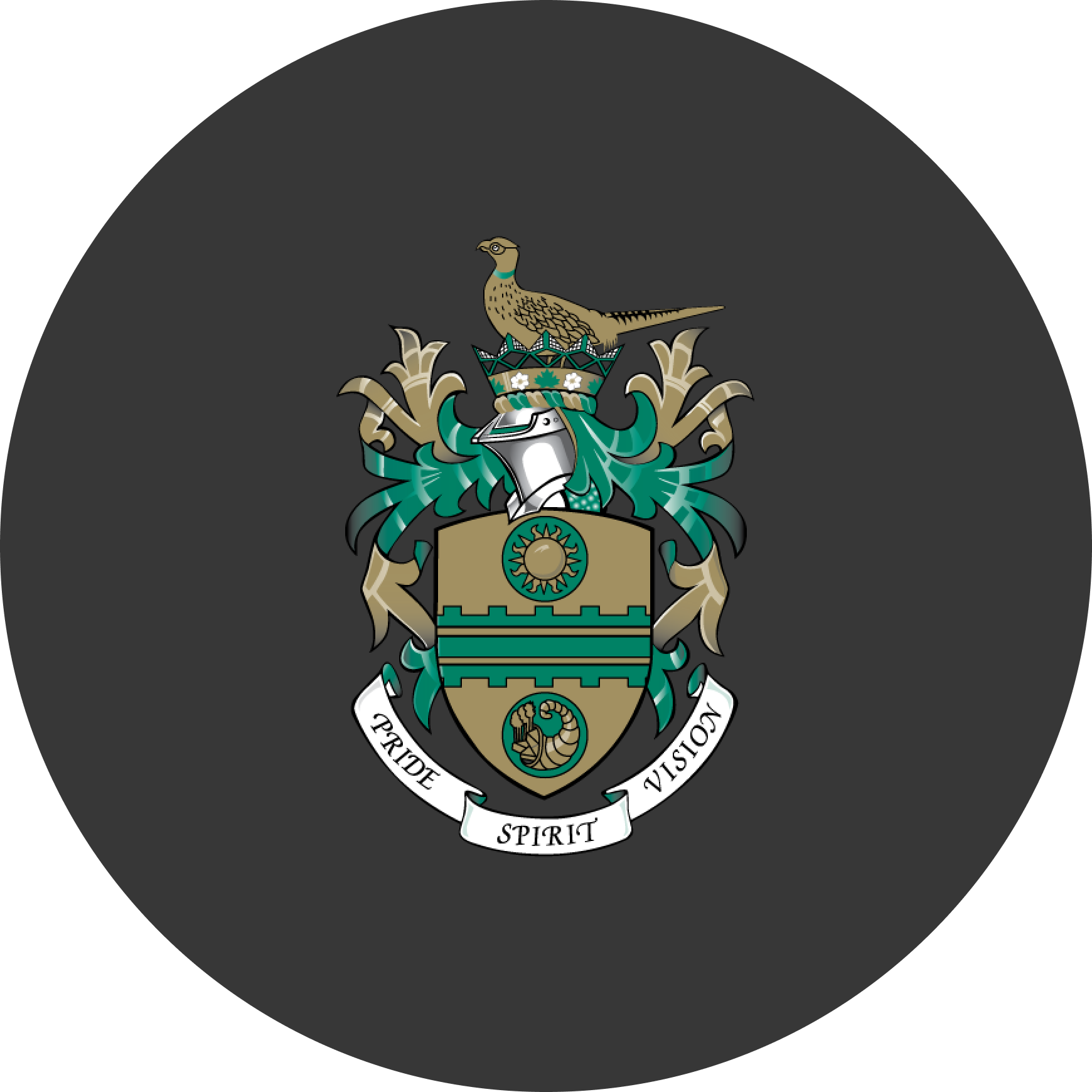City History
In 1885 William Charles Heaton-Armstrong started a private bank and arranged a successful issue of bonds for the Shuswap and Okanagan Railway. The town was later named for him, and when work was completed on the Railway in 1892, it consisted of a lone boxcar that served as a station and home for the rail agent. As one pioneer remarked, “Apart from the box car, there was just willows and swamp.”
Citizens of Lansdowne, the largest settlement in Spallumcheen, migrated to resettle on the tracks. The Lansdowne community packed up structures and their belongings, and relocated to the railway and Armstrong. Today the only standing testimony of this once sprawling western town is the old Lansdowne cemetery.
Armstrong was incorporated as a City Municipality on March 26, 1913.



































Coat of Arms and Flag
Arms (Shield)
The sun of the shield represents a sun in splendor and the cornucopia represents cheeses and celery stalks issuing from its mouth. Armstrong has long been known for its famous Armstrong Cheese, which used to be produced in the City.
As well, in its early days Armstrong boasted large fields of celery. The railway tracks represent tracks that have run through the center of the City since its incorporation.
Crest (above the shield)
A helmet mantled with a frieze of maple leaves alternating with dogwood flowers. The maple leaves represent Canada and the dogwood flowers represent the provincial flower.
The Lacrosse sticks represent the game that has long been a part of Armstrong’s history. The ring necked pheasant is representative of a bird that has made Armstrong its home.
Flag
In the classic manner of heraldry, the flag is composed of a banner divided in the same fashion as the shield, with a sun in the top left corner, the railroad tracks running across the middle and a cornucopia in the bottom right corner.

Coat of Arms and Flag
Arms (Shield)
The sun of the shield represents a sun in splendor and the cornucopia represents cheeses and celery stalks issuing from its mouth. Armstrong has long been known for its famous Armstrong Cheese, which used to be produced in the City. As well, in its early days Armstrong boasted large fields of celery. The railway tracks represent tracks that have run through the center of the City since its incorporation.
Crest (above the shield)
A helmet mantled with a frieze of maple leaves alternating with dogwood flowers. The maple leaves represent Canada and the dogwood flowers represent the provincial flower. The Lacrosse sticks represent the game that has long been a part of Armstrong’s history. The ring necked pheasant is representative of a bird that has made Armstrong its home.
Flag
In the classic manner of heraldry, the flag is composed of a banner divided in the same fashion as the shield, with a sun in the top left corner, the railroad tracks running across the middle and a cornucopia in the bottom right corner.
Rathfriland Sister City
In 2015, the City of Armstrong established a Sister City Agreement with Rathfriland, an agricultural community within County Down in Northern Ireland, and the 1835 birthplace of Catherine (O’Hare) Schubert.
O’Hare sailed to the United States when she was 16-years-old and within a few years married a German carpenter, Augustus Schubert. The Schubert’s contributed locally as Round Prairie Road farming pioneers. Catherine, historically known as Lady Overlander, was the first European woman to enter British Columbia by trekking overland across the Canadian prairies and over the Rockies – doing so with her children ages five, three and one. More amazingly, she began the trek carrying her fourth child, concealing her second-trimester of pregnancy. With the trip taking longer than anticipated, Catherine went into labour while on a raft on the Thompson River.
Her baby girl Rose, became the first girl of European heritage born in British Columbia. Rose Swanson Mountain, one of the local hiking mountains, is named in her honour.
Rathfriland Sister City
In 2015, the City of Armstrong established a Sister City Agreement with Rathfriland, an agricultural community within County Down in Northern Ireland, and the 1835 birthplace of Catherine (O’Hare) Schubert.
O’Hare sailed to the United States when she was 16-years-old and within a few years married a German carpenter, Augustus Schubert. The Schubert’s contributed locally as Round Prairie Road farming pioneers. Catherine, historically known as Lady Overlander, was the first European woman to enter British Columbia by trekking overland across the Canadian prairies and over the Rockies – doing so with her children ages five, three and one. More amazingly, she began the trek carrying her fourth child, concealing her second-trimester of pregnancy. With the trip taking longer than anticipated, Catherine went into labour while on a raft on the Thompson River.
Her baby girl Rose, became the first girl of European heritage born in British Columbia. Rose Swanson Mountain, one of the local hiking mountains, is named in her honour.

The Heritage Inventory & Heritage Registry
The City of Armstrong Heritage Resource Management Plan was prepared in July 1993. Along with it, the Heritage Resource Inventory was created – an unofficial inventory of properties that are of historic interest. The Heritage Inventory includes information on more than 70 properties that were built prior to 1930 and which have heritage qualities. The listings include reports on architecture, resident history, and photographs from past and present.
Consideration is given for buildings that represent outstanding craftsmanship, have specific historical relevance including a figure or event, exemplify a specific architectural style unique to the area, illustrate a particular time period in the history of the City of Armstrong, or showcase the development of a city over time.
The Heritage Inventory & Heritage Registry
The City of Armstrong Heritage Resource Management Plan was prepared in July 1993. Along with it, the Heritage Resource Inventory was created – an unofficial inventory of properties that are of historic interest. The Heritage Inventory includes information on more than 70 properties that were built prior to 1930 and which have heritage qualities. The listings include reports on architecture, resident history, and photographs from past and present.
Consideration is given for buildings that represent outstanding craftsmanship, have specific historical relevance including a figure or event, exemplify a specific architectural style unique to the area, illustrate a particular time period in the history of the City of Armstrong, or showcase the development of a city over time.
tHE rEGISTRY
The Community Heritage Registry (CHR) was enacted by Council resolution on February 12, 2007. Heritage designation is a method of legally protecting and conserving heritage properties, and buildings can be classified by heritage value or heritage character. The properties in the listing were designated heritage through bylaws that aim to legally protect and conserve heritage importance in the community.
tHE rEGISTRY
The Community Heritage Registry (CHR) was enacted by Council resolution on February 12, 2007. Heritage designation is a method of legally protecting and conserving heritage properties, and buildings can be classified by heritage value or heritage character.
The properties in the listing were designated heritage through bylaws that aim to legally protect and conserve heritage importance in the community.
Guidelines for Heritage Designation
Heritage designation is a method of legally protecting and conserving heritage properties.
For more information, click here to view an article written by Ben McMahen, that was included in the Summer 2004 issue of the Heritage B.C. Newsletter.

Guidelines for Heritage Designation
Heritage designation is a method of legally protecting and conserving heritage properties.
For more information, click here to view an article written by Ben McMahen, that was included in the Summer 2004 issue of the Heritage B.C. Newsletter.
Guidelines for Heritage Alterations
Heritage Alteration Permits are required for the following actions, however reasonable requests that are in keeping with the heritage character of the building and are consistent with the purpose for heritage protection of the property are not likely to be refused. Interior renovations can be carried out without any alteration permits.
– Altering the exterior of the building
– Making a structural change to the building
– Moving the building
– Altering, removing or damaging a protected landscape features
Guidelines for Heritage Alterations
Heritage Alteration Permits are required for the following actions, however reasonable requests that are in keeping with the heritage character of the building and are consistent with the purpose for heritage protection of the property are not likely to be refused. Interior renovations can be carried out without any alteration permits.
- Altering the exterior of the building
- Making a structural change to the building
- Moving the building
- Altering, removing or damaging a protected landscape features
Heritage Alteration Permits
Heritage Alteration Permits are required for altering the exterior of the building, making a structural change to the building, moving the building, or altering, removing or damaging a protected landscape feature. Get more information here.
To apply for a Heritage Alteration Permit please contact the City at (250) 546-3023, or email at info@cityofarmstrong.bc.ca
Heritage Colour Palette
These colours were taken from the original Heritage buildings in Armstrong B.C. and are part of Benjamin Moore’s Heritage Collection.
Heritage Grant Program
Once you have received heritage designation you could be eligible for funds to assist in the preservation, maintenance and restoration of your heritage buildings.
Information about the Heritage Grant Program please contact the City at (250) 546-3023, or email at info@cityofarmstrong.bc.ca
Heritage Alteration Permits
Heritage Alteration Permits are required for altering the exterior of the building, making a structural change to the building, moving the building, or altering, removing or damaging a protected landscape feature. Get more information here.
To apply for a Heritage Alteration Permit please contact the City at (250) 546-3023, or email at info@cityofarmstrong.bc.ca
Heritage Colour Palette
These colours were taken from the original Heritage buildings in Armstrong B.C. and are part of Benjamin Moore’s Heritage Collection.
Heritage Grant Program
Once you have received heritage designation you could be eligible for funds to assist in the preservation, maintenance and restoration of your heritage buildings. Information about the Heritage Grant Program please contact the City at (250) 546-3023, or email at info@cityofarmstrong.bc.ca
Armstrong’s
Heritage Properties
Please submit updated photos of your property to info@cityofarmstrong.bc.ca


Armstrong’s Heritage Properties
Please submit updated photos of your property to info@cityofarmstrong.bc.ca
















































About Armstrong
The City of Armstrong is a friendly community with a beautiful trails network, bustling downtown core and peaceful family-friendly atmosphere.
We welcome all those who wish to visit, live, or invest in this peaceful little city. Armstrong considered the “Heart of Country” is located in the heart of Spallumcheen Valley, between the sunny Okanagan and the bright Shuswap Valleys.

